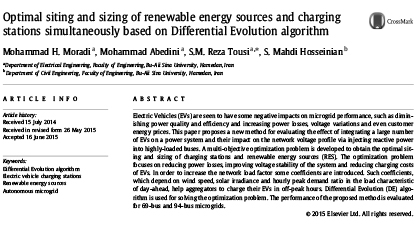Electric vehicles’ chargers are seen to be beneficial for both consumers and grid. In this paper. the use of EVs on the Microgrid performance was explored. A multi-objective optimization problem comprising the amount of charging discharging cost. power loss and voltage profile was developed. Differential Evolution algorithm was adopted to solve the paper optimization problem. The performance of the proposed method was simulated in MATLAB for different microgrids. The simulation results provided the optimal place and size of charging stations along with the number of EVs based on optimal load factor. power loss and voltage profile.
The paper shows that an appropriate EVs scheduling improves the network voltage profile via removing voltage drops in highly-loaded buses. The paper also shows that the use of the proposed coeffi- cients in the paper objective functions increases the load factor while it shifts the EVs demand into hours with high speed of wind and solar radiation level. Additionally. the paper demonstrates that discharging of EVs improves the load factor and reduces the energy cost for both consumers and microgrid. Finally. the paper shows that the use of EVs as active and reactive power sources helps improving the hourly demand. reducing energy costs and improving voltage profile in the network by utilizing optimal charging stations for EVs.
 Iran Energy News Oil, Gas, Petrochemical and Energy Field Specialized Channel
Iran Energy News Oil, Gas, Petrochemical and Energy Field Specialized Channel




